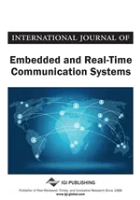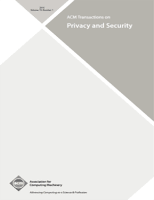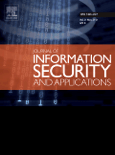
Journal of Cryptographic Engineering
Scope & Guideline
Empowering researchers to unlock the potential of cryptographic engineering.
Introduction
Aims and Scopes
- Cryptographic Algorithms and Protocols:
The journal covers the design, analysis, and implementation of cryptographic algorithms and protocols, including symmetric and asymmetric encryption schemes, digital signatures, and authentication protocols. - Security Analysis and Attack Methods:
Research on various forms of security analysis, including side-channel attacks, fault attacks, and their countermeasures is a prominent focus, addressing the vulnerabilities of cryptographic systems. - Hardware and Software Implementations:
The journal emphasizes the engineering aspects of cryptographic implementations, including hardware accelerators, FPGA designs, and software optimizations for cryptographic operations. - Post-Quantum Cryptography:
With the advent of quantum computing, the journal has increasingly focused on post-quantum cryptographic schemes, exploring their security, efficiency, and implementation challenges. - Machine Learning in Cryptography:
The integration of machine learning techniques in cryptographic analysis and security is an emerging area of interest, particularly for side-channel attacks and vulnerability detection.
Trending and Emerging
- Side-Channel Attack Mitigation:
There is a growing emphasis on advanced techniques to mitigate side-channel attacks, with innovative methodologies being developed to enhance the security of cryptographic implementations against such vulnerabilities. - Post-Quantum Cryptography Research:
Research surrounding post-quantum cryptographic schemes is increasingly prominent, addressing the imminent challenges posed by quantum computing and the need for secure algorithms. - Hardware Security and Fault Injection:
The journal has seen a rise in studies focused on hardware security, particularly fault injection attacks and hardware Trojan detection, emphasizing the need for robust hardware designs. - Machine Learning Applications in Cryptography:
The application of machine learning in cryptographic contexts, particularly for analyzing vulnerabilities and enhancing security measures, is an emerging theme that is gaining significant attention. - Efficiency in Cryptographic Implementations:
Research aimed at improving the efficiency of cryptographic algorithms and their implementations, including energy-efficient designs and hardware acceleration techniques, is increasingly relevant in the context of IoT and mobile devices.
Declining or Waning
- Traditional Cryptographic Techniques:
The focus on classical cryptographic techniques, such as older block ciphers and hashing algorithms, is waning as newer, more secure methods and post-quantum approaches gain traction. - Static Analysis of Cryptographic Protocols:
Research dedicated to static analysis methods for cryptographic protocols appears to be decreasing, possibly due to the growing complexity of dynamic and adaptive attack scenarios. - Basic Theoretical Foundations:
While foundational studies are important, there has been a noticeable reduction in publications centered solely on theoretical aspects without practical implications, as the field moves towards more application-oriented research.
Similar Journals

IACR Transactions on Symmetric Cryptology
Illuminating the Path to Enhanced Security TechnologiesIACR Transactions on Symmetric Cryptology, published by the esteemed RUHR-UNIV BOCHUM at the Horst Gortz Institute for IT Security, stands as a beacon of innovation in the field of cryptology. With an E-ISSN of 2519-173X and a commitment to open access since 2016, this journal provides a platform for groundbreaking research that enhances our understanding and application of symmetric cryptographic methods. Reflecting its high academic standing, the journal boasts a Q1 ranking in categories such as Applied Mathematics, Computational Mathematics, and Computer Science Applications, positioning it among the top tiers of scholarly publications internationally. Researchers, professionals, and students are encouraged to contribute and access vital cutting-edge studies that inform both theoretical and practical advances in secure communication technologies. Situated in Bochum, Germany, the IACR Transactions on Symmetric Cryptology is an essential resource for anyone invested in the future of cryptographic research.

Digital Communications and Networks
Pioneering research in digital communications.Digital Communications and Networks, published by KEAI PUBLISHING LTD, stands at the forefront of research in the rapidly evolving fields of communication, computer networks, and hardware architecture. Since its inception in 2015, this open access journal has been committed to disseminating high-quality, peer-reviewed articles that contribute to technological advancements and academic discourse in these critical domains. With an impressive Impact Factor and achieving Q1 Quartile rankings in its relevant categories for 2023, it has established itself as a vital resource for researchers, professionals, and students aiming to stay ahead in a competitive landscape. The journal's robust standing is reflected in its notable Scopus rankings, underscoring its influence in Computer Science and related fields. As we look toward the future, the journal continues to invite innovative research that shapes the digital communication landscape until 2024 and beyond.

International Journal of Embedded and Real-Time Communication Systems (IJERTCS)
Advancing Embedded Communication for a Connected FutureInternational Journal of Embedded and Real-Time Communication Systems (IJERTCS), published by IGI Global, stands at the forefront of research in the domain of communication systems that operate on embedded and real-time frameworks. With its ISSN 1947-3176 and E-ISSN 1947-3184, this peer-reviewed journal has been a crucial platform for disseminating groundbreaking research and practical applications from 2010 to 2023. Although currently categorized in the Q4 quartile of computer science in Scopus, the journal offers unique insights into innovative communication strategies that bridge theoretical concepts with real-world implementation. Researchers, practitioners, and students alike rely on IJERTCS for comprehensive studies that address both contemporary challenges and future prospects in embedded systems. The journal enhances the academic discourse through highly relevant articles, supporting the development of robust communication technologies that are becoming increasingly vital in our interconnected world.

Journal of Mathematical Cryptology
Bridging Theory and Application in the World of Mathematical CryptologyThe Journal of Mathematical Cryptology, published by DE GRUYTER POLAND SP Z O O, is a pioneering open-access journal that has been a valuable resource for researchers and professionals in the field of mathematical cryptography since its inception in 2007. With an ISSN of 1862-2976 and an E-ISSN of 1862-2984, this journal provides a platform for cutting-edge research, aiming to address the complexities and challenges presented by the evolving landscape of cybersecurity. As of 2023, the journal holds a respectable Q3 ranking in Applied Mathematics, Computational Mathematics, and Computer Science Applications, reflecting its relevance and growing impact within these disciplines. Although it currently has an H-index of "-", the qualitative contributions of the journal are recognized through its Scopus rankings, including a placement in the 58th percentile for Applied Mathematics. The journal is committed to fostering collaboration and innovation in mathematical methodologies applied to cryptography, thus attracting a diverse audience of researchers, students, and industry professionals. By embracing an open-access model since 2020, the Journal of Mathematical Cryptology enhances the visibility and accessibility of essential research findings, making it a crucial resource in the academic community.

ACM Transactions on Privacy and Security
Transforming Challenges into Solutions in Data Security.ACM Transactions on Privacy and Security, published by the Association for Computing Machinery, is a prestigious journal dedicated to the field of computer science, with a particular focus on privacy and security in modern computing environments. Since its inception in 2016, this journal has become a vital resource for researchers, professionals, and students alike, addressing the increasing concerns surrounding data protection and risk management. With an impressive impact factor and recognition as a Q1 journal in both Computer Science (Miscellaneous) and Safety, Risk, Reliability and Quality, it ranks among the top publications in its field, positioned at the 73rd percentile in General Computer Science and the 71st percentile in Engineering. The journal’s Open Access options enhance accessibility to cutting-edge research, fostering collaboration and innovation in the rapidly evolving landscape of privacy and security. Readers can expect high-quality peer-reviewed articles that contribute significantly to both theoretical and practical advancements in technology and data security.

Cryptography and Communications-Discrete-Structures Boolean Functions and Sequences
Innovating the future of secure communication protocols.Cryptography and Communications - Discrete Structures, Boolean Functions and Sequences is a distinguished journal published by Springer, focusing on the crucial intersections of cryptography, discrete mathematics, and communication systems. With a significant presence in the academic community since its inception in 2009, the journal has established a robust reputation, holding a Q1 ranking in Applied Mathematics and notable positions in other relevant categories, reflecting its impact in the field. Researchers and professionals will find this journal engaging as it rigorously explores the theoretical underpinnings and practical applications of boolean functions and sequences, essential for advancing secure communication protocols and efficient data processing. Despite not currently offering open access, the journal is highly regarded for its quality peer-reviewed articles, making it a vital resource for scholars aiming to contribute to or stay at the forefront of cryptographic research. Its continual publication through 2024 ensures an ongoing dialogue in this rapidly evolving field, enhancing understanding and innovation among its readership in the United States and beyond.

ISeCure-ISC International Journal of Information Security
Advancing the Frontiers of Information SecurityISeCure-ISC International Journal of Information Security, published by the Iranian Society of Cryptology, is a vital open-access platform dedicated to advancing the field of information security. Since its inception in 2009, the journal has strived to disseminate high-quality, peer-reviewed research that addresses contemporary challenges in information security, cryptography, and related computational disciplines. With an ISSN of 2008-2045 and an E-ISSN of 2008-3076, it has gained visibility in the academic community, evidenced by its Quartile 4 ranking across multiple categories such as Applied Mathematics, Computational Theory, and Information Systems. This journal aims to foster innovative solutions and theoretical advancements, targeting researchers, professionals, and students who seek to contribute to and learn from the latest developments in the field. By providing a venue for explorative and empirical research, ISeCure-ISC holds an important position in promoting knowledge and collaborative efforts within the global information security landscape.

PROGRAMMING AND COMPUTER SOFTWARE
Exploring the Frontiers of Software Engineering ExcellencePROGRAMMING AND COMPUTER SOFTWARE is a distinguished journal committed to advancing the field of software development and programming methodologies. Published by PLEIADES PUBLISHING INC, this journal has been a valuable resource since its inception in 1978, reaching out to researchers, professionals, and students alike. With an emphasis on rigorous peer-reviewed articles, the journal holds a Q3 ranking in the realm of Software according to the latest 2023 Category Quartiles. Though it does not offer open access, the journal ensures that high-quality research is disseminated to its audience, providing insights into evolving programming techniques, software engineering challenges, and innovative solutions. With its convergence of years extending to 2024, PROGRAMMING AND COMPUTER SOFTWARE remains a pivotal publication, fostering a deeper understanding of the complexities in computer programming while supporting the broader software community.

JOURNAL OF INFORMATION SCIENCE AND ENGINEERING
Connecting Researchers in the Evolving World of Information.JOURNAL OF INFORMATION SCIENCE AND ENGINEERING, published by the Institute of Information Science in Taiwan, is a pivotal platform for the dissemination of innovative research in the multidisciplinary fields of information science and engineering. Established in 1993, the journal primarily focuses on areas such as library and information sciences, human-computer interaction, hardware and architecture, as well as computational theory and software development. Despite holding a current Q4 ranking in several categories, the journal demonstrates significant potential for growth, particularly in computation and software systems, as evidenced by its Scopus rankings and percentiles. Researchers, professionals, and students will find this journal to be an invaluable resource to stay abreast of evolving theories and technologies in information science. The journal is accessible through traditional subscription models, fostering a broad academic outreach. It serves to enhance knowledge-sharing and collaboration within this dynamic and ever-evolving field.

Journal of Information Security and Applications
Unveiling Insights in Information Security ExcellenceJournal of Information Security and Applications, published by ELSEVIER, is a premier outlet for cutting-edge research in the field of information security and applications. With a dedicated ISSN of 2214-2126 and an E-ISSN of 2214-2134, this journal ranks impressively in the top quartile (Q1) across multiple categories as of 2023, including Computer Networks and Communications, Safety, Risk, Reliability and Quality, and Software. The journal’s notable Scopus rankings further reflect its impact, holding positions within the top 15% in several engineering and computer science areas. Spanning a converged period from 2013 to 2024, the journal aims to disseminate high-quality research findings, facilitating a vibrant platform for scholars, practitioners, and students to engage with contemporary challenges in information security. Although not an open-access journal, the knowledge shared within its pages is indispensable for those dedicated to advancing the technological and theoretical underpinnings of security measures in various applications.